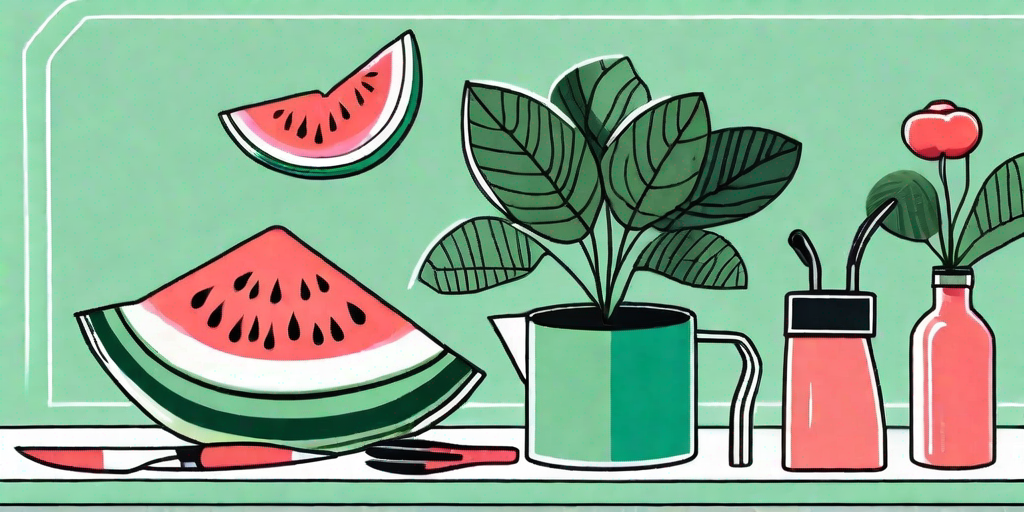
If you're a plant lover, you're probably familiar with the Watermelon Peperomia, a plant known for its striking resemblance to a watermelon slice. But, what do you do when your beloved plant starts showing brown spots? Don't worry, we've got you covered. Let's dive into the world of plant care and bid adieu to those pesky brown spots.
Understanding Your Watermelon Peperomia
Before we start, it's essential to understand your plant. The Watermelon Peperomia, scientifically known as Peperomia argyreia, is a tropical plant native to South America. It's loved for its round, glossy leaves that are green on top and red underneath - just like a juicy watermelon!
Despite its tropical origins, this plant is surprisingly easy to care for. It's a favorite among beginners and experienced gardeners alike. However, like any living thing, it can fall prey to a few problems, one of them being brown spots. But fear not, we're here to help you tackle this issue head-on.
Identifying the Cause of Brown Spots
Before you can start treating your plant, you need to identify the cause of the brown spots. Several factors can lead to this problem, including overwatering, low humidity, and pests.
Overwatering is a common mistake made by many plant parents. While your Watermelon Peperomia loves a good drink, too much water can lead to root rot, which in turn causes brown spots on the leaves. On the other hand, low humidity can cause the leaves to dry out and develop brown patches. Lastly, pests like spider mites and mealybugs can also cause brown spots on your plant.
Overwatering
Overwatering is the plant equivalent of having too much of a good thing. While your Watermelon Peperomia needs water to survive, too much can lead to root rot. This condition causes the roots to become waterlogged and oxygen-starved, leading to the death of the plant's cells. As a result, brown spots appear on the leaves.
The best way to avoid overwatering is to follow a watering schedule. Water your plant when the top 1-2 inches of soil feel dry to the touch. Also, make sure your plant pot has good drainage to prevent water from pooling at the bottom.
Low Humidity
As a tropical plant, your Watermelon Peperomia loves high humidity. However, most homes don't have the same humidity levels as a tropical rainforest. This discrepancy can cause the leaves of your plant to dry out and develop brown spots.
To increase the humidity around your plant, you can use a humidifier or place a tray of water near your plant. The water will evaporate and increase the humidity in the surrounding air. Alternatively, you can mist your plant with water, but be careful not to overdo it as this can lead to other problems like fungal infections.
Pests
Pests are the uninvited guests that every plant parent dreads. Spider mites and mealybugs are particularly fond of the Watermelon Peperomia and can cause brown spots on the leaves.
Regularly inspect your plant for signs of pests. If you spot any, treat your plant immediately with an insecticidal soap or neem oil. Remember, prevention is better than cure, so keep your plant clean and healthy to prevent pests from setting up camp.
FAQs
- How often should I water my Watermelon Peperomia?
- Water your plant when the top 1-2 inches of soil feel dry to the touch. This usually means watering once a week, but it can vary depending on the temperature and humidity in your home.
- What kind of light does my Watermelon Peperomia need?
- Your plant prefers bright, indirect light. Too much direct sunlight can cause the leaves to burn, while too little light can cause the leaves to become pale and leggy.
- How do I increase the humidity for my Watermelon Peperomia?
- You can use a humidifier, place a tray of water near your plant, or mist your plant with water. However, be careful not to overdo it as this can lead to other problems like fungal infections.
Final Thoughts
Caring for a Watermelon Peperomia can be a rewarding experience. With its beautiful, watermelon-like leaves, it's a plant that's sure to brighten up any room. However, like any plant, it can have its fair share of problems.
Remember, the key to a healthy plant is understanding its needs and providing the right care. So, say goodbye to those brown spots and hello to a healthy, happy Watermelon Peperomia!















